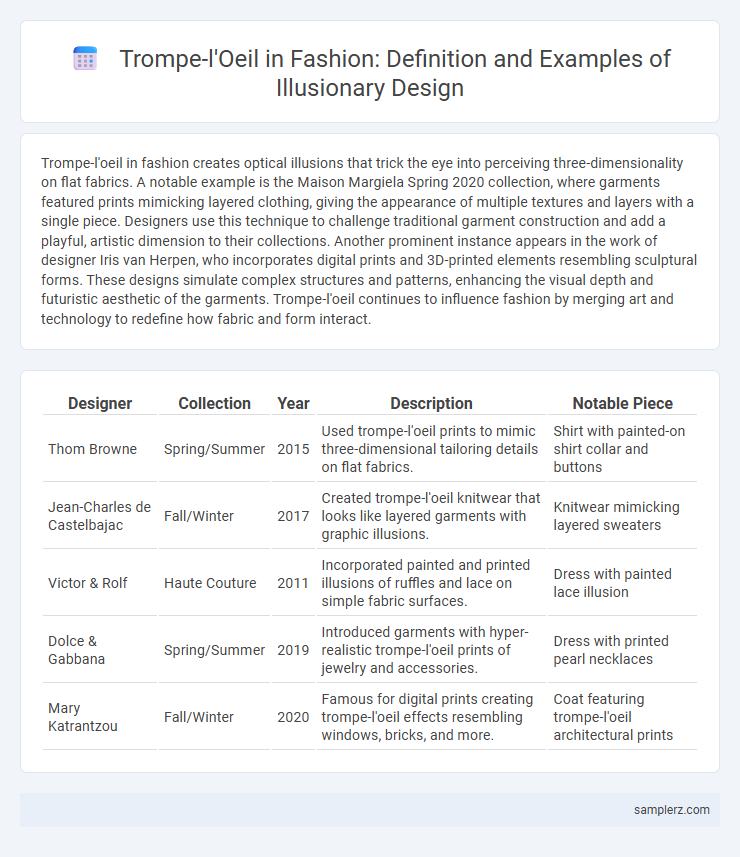Trompe-l'oeil in fashion creates optical illusions that trick the eye into perceiving three-dimensionality on flat fabrics. A notable example is the Maison Margiela Spring 2020 collection, where garments featured prints mimicking layered clothing, giving the appearance of multiple textures and layers with a single piece. Designers use this technique to challenge traditional garment construction and add a playful, artistic dimension to their collections. Another prominent instance appears in the work of designer Iris van Herpen, who incorporates digital prints and 3D-printed elements resembling sculptural forms. These designs simulate complex structures and patterns, enhancing the visual depth and futuristic aesthetic of the garments. Trompe-l'oeil continues to influence fashion by merging art and technology to redefine how fabric and form interact.
Table of Comparison
| Designer | Collection | Year | Description | Notable Piece |
|---|---|---|---|---|
| Thom Browne | Spring/Summer | 2015 | Used trompe-l'oeil prints to mimic three-dimensional tailoring details on flat fabrics. | Shirt with painted-on shirt collar and buttons |
| Jean-Charles de Castelbajac | Fall/Winter | 2017 | Created trompe-l'oeil knitwear that looks like layered garments with graphic illusions. | Knitwear mimicking layered sweaters |
| Victor & Rolf | Haute Couture | 2011 | Incorporated painted and printed illusions of ruffles and lace on simple fabric surfaces. | Dress with painted lace illusion |
| Dolce & Gabbana | Spring/Summer | 2019 | Introduced garments with hyper-realistic trompe-l'oeil prints of jewelry and accessories. | Dress with printed pearl necklaces |
| Mary Katrantzou | Fall/Winter | 2020 | Famous for digital prints creating trompe-l'oeil effects resembling windows, bricks, and more. | Coat featuring trompe-l'oeil architectural prints |
Iconic Trompe-l’Oeil Moments on the Runway
Iconic trompe-l'oeil moments on the runway include Elsa Schiaparelli's 1937 skeleton dress, which created an illusion of the skeletal structure beneath the fabric. Jean Paul Gaultier's trompe-l'oeil corsetry and lingerie-inspired designs often blurred the lines between clothing and body, captivating audiences with visual trickery. Moschino's playful trompe-l'oeil prints, resembling sewn-on patches and zippers, emphasize the art of illusion in contemporary fashion.
Celebrity Outfits Featuring Trompe-l’Oeil Designs
Celebrities like Rihanna and Zendaya have famously worn outfits featuring trompe-l'oeil designs, creating optical illusions that mimic layers or textures on fabric. Rihanna's sheer Bodysuit with intricately painted lace detailing showcased a stunning 3D effect, blurring the line between clothing and skin. Zendaya's trompe-l'oeil gown at the Met Gala stunned with its hyper-realistic nylon gloves and tattoo-like prints, exemplifying this artistic fashion technique.
Famous Designers Known for Trompe-l’Oeil in Fashion
Famous designers like Elsa Schiaparelli revolutionized fashion with trompe-l'oeil by creating garments that mimic three-dimensional objects through painted or printed illusions. Jean Paul Gaultier frequently incorporates trompe-l'oeil to blur the lines between clothing and body art, enhancing visual complexity in his collections. Viktor & Rolf also utilize trompe-l'oeil techniques to transform silhouettes and textures, pushing the boundaries of wearable art.
Memorable Trompe-l’Oeil Print Collections
Memorable trompe-l'oeil print collections in fashion include Prada's Fall 2018 line, which featured realistic 3D shoe prints that created optical illusions on garments. Jean Paul Gaultier's iconic collections often incorporate trompe-l'oeil corset and lace prints, blending texture and depth on flat fabrics. These prints leverage intricate detailing and shading techniques to trick the eye, enhancing visual interest and pushing garment creativity.
The Evolution of Trompe-l’Oeil in Contemporary Fashion
Trompe-l'oeil in contemporary fashion has evolved from simple print illusions to complex, multi-layered designs that challenge perception and blur the line between reality and art. Designers like Viktor & Rolf and Maison Margiela incorporate trompe-l'oeil techniques to create garments that mimic textures, layers, or three-dimensional effects, transforming clothing into wearable optical illusions. This evolution reflects a growing trend in fashion toward innovation and conceptual creativity, leveraging digital printing and advanced tailoring to enhance the visual impact of trompe-l'oeil.
Influence of Surrealism on Trompe-l’Oeil Garments
Surrealism's impact on trompe-l'oeil garments is exemplified by designs that challenge visual perception, such as Elsa Schiaparelli's iconic lobster dress and Salvador Dali's melting clock motifs incorporated into fabric prints. These pieces blur reality and illusion, creating garments that appear three-dimensional or deceptively textured. Contemporary designers like Thom Browne continue this tradition, using surrealist-inspired trompe-l'oeil techniques to transform ordinary silhouettes into playful, mind-bending visual experiences.
How Streetwear Embraces Trompe-l’Oeil Techniques
Streetwear incorporates trompe-l'oeil techniques by using graphic prints that create optical illusions of layered clothing or three-dimensional details on flat fabrics. Brands like Off-White and Vetements popularize designs featuring faux zippers, pockets, or stitching that mislead the eye, adding depth and artistic complexity to everyday apparel. This approach enhances streetwear's visual impact by blending art and fashion through clever visual deception.
Accessories Featuring Trompe-l’Oeil Illusions
Accessories featuring trompe-l'oeil illusions create captivating visual effects by mimicking three-dimensional shapes and textures on flat surfaces. Notable examples include handbags with printed chains and buckles that appear sculptural, as well as scarves designed with intricate shadowing that deceives the eye into perceiving folds and layers. These innovative designs enhance fashion ensembles by adding a playful yet sophisticated element of optical illusion.
Trompe-l’Oeil in Sustainable and Upcycled Fashion
Trompe-l'oeil in sustainable and upcycled fashion creates visual illusions that transform discarded or vintage fabrics into innovative garments, enhancing aesthetic appeal while reducing waste. Designers leverage intricate prints and layering techniques to mimic textures and shapes, offering eco-friendly alternatives to new textile production. This approach not only elevates recycled materials but also promotes conscious consumption within the fashion industry.
DIY Trompe-l’Oeil Fashion Projects to Try
DIY trompe-l'oeil fashion projects transform ordinary garments into optical illusions that mimic 3D textures or layered looks, sparking creativity with fabric paints and applique techniques. Popular examples include painted pockets, faux buttons, or layered scarves rendered directly onto t-shirts and jackets, showcasing detailed realism that tricks the eye. Fashion enthusiasts can experiment with stencil art and shading to create illusions of ruffles, jewelry, or intricate embroidery, enhancing personal style with affordable, imaginative designs.

example of trompe-l’oeil in fashion Infographic
 samplerz.com
samplerz.com